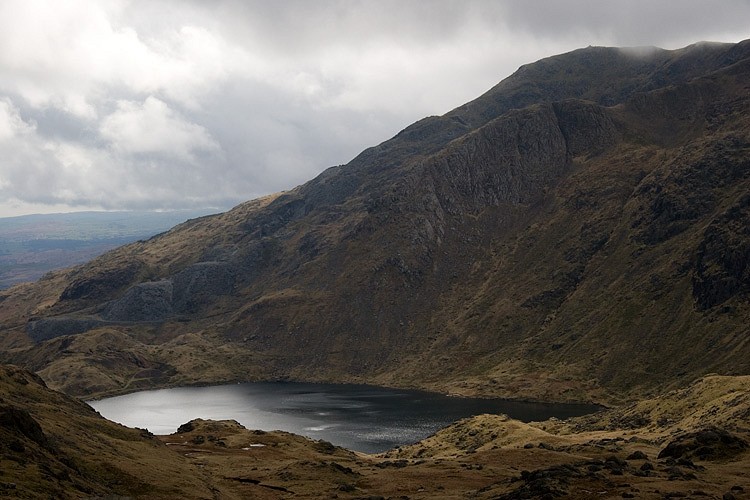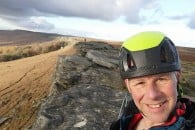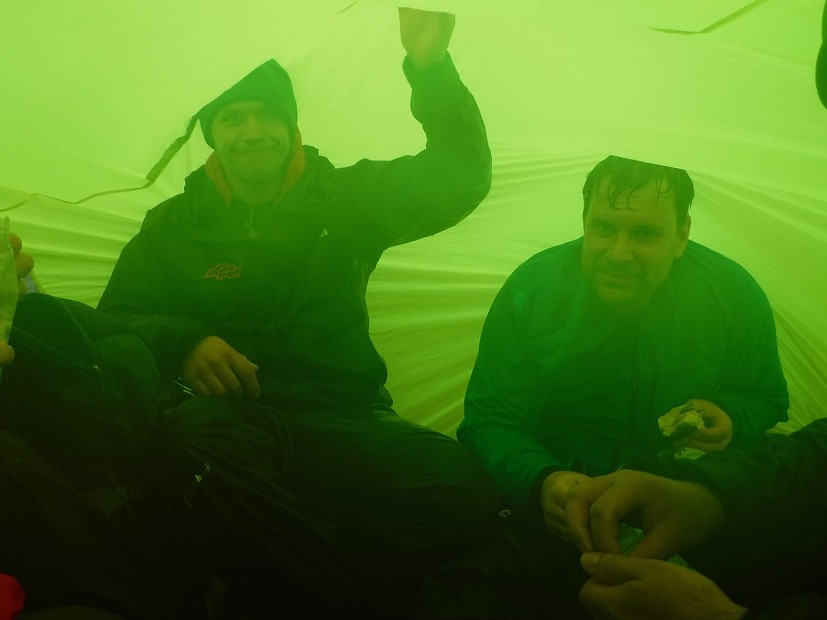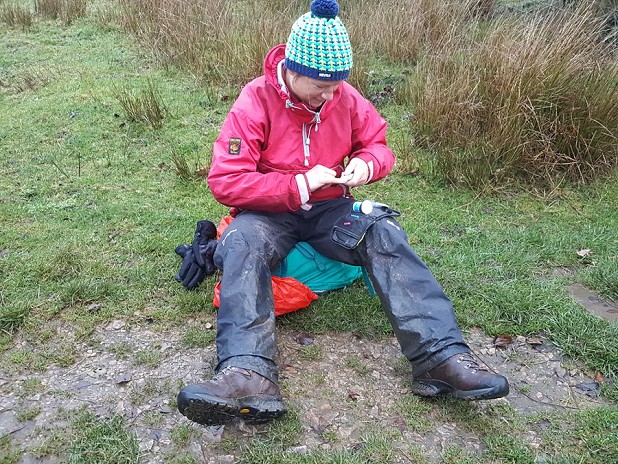How to Save a Life With a Flapjack – Diabetes on the Hill
People with diabetes can - and should - enjoy hillwalking as much as anyone. But if a member of your party had a problem with their blood sugar, would you know how to help...?
It was a cold and wet Lake District day - a working day for me, and so I had a group of fairly fit and experienced walkers with me. Our chosen route was slightly off the beaten track, and away from the hordes as much as possible (not that many people were out that day). Slowly we plodded on uphill towards a place called Levers Hawse. Full waterproofs were deployed and as you do on days like these, we occupied our own private worlds tucked away inside our hoods and hats. Unlike the streams around us, conversation was hardly flowing.
Eventually we made it to the top – and on most days the view from this summit ridge-line down to Seathwaite Tarn in the next valley is worth savouring.
If someone is taking insulin, they need to adjust their levels according to the amount of exercise - and this can be tricky to get right
As I stopped and looked around to see how people were, I immediately noticed that something looked wrong with Diana. Through the weekend she had on many occasions been checking her blood sugar levels and so I was well reminded that here was a lass with diabetes. So my first question was – "Di, are you hypoglycaemic?" She said nothing, looking a bit like a zombie, and nodded.

Diabetes – what is it?
When someone has diabetes, they lack the ability to control their blood sugar levels. Normally when we eat food we consume sugar: spuds, apples and chocolate for example all provide sugar in one form or another.
Our bodies are generally clever at working out how much sugar we need at any one time. And so as we consume food and our blood-sugar levels rise our body tempers the blood-sugar levels by producing insulin (which in turn lowers the blood sugar). Someone with type 1 diabetes however isn't able to produce insulin. A type 2 diabetic produces insulin, but their body is resistant to it.
A person with diabetes goes to see a doctor (an endocrinologist) who helps them to work out how much insulin they may need to inject themselves with or treats them with tablets on a daily basis, based on their average activity levels. If they take insulin, they will typically monitor their blood sugar levels throughout the day to ensure that they have the right amount.
As far as the first-aider is concerned it doesn't matter if the casualty has type 1 or type 2 diabetes.
What do we see?
When someone increases their daily exercise levels by say going hill walking, or mountain biking or rock climbing, then they are likely to burn off their blood-sugar levels naturally through this activity. However, if they are taking insulin, they need to adjust their levels according to the amount of exercise, and this can be tricky to get right. In this case, they might suffer from hypoglycaemia (low blood sugar) if they have too much insulin or too little food.
Symptoms include: shakiness, cold sweaty skin, confusion, tiredness and most commonly a noticeable change in mood/behaviour: the casualty with low blood sugars looks really hacked off or could even be uncontrollably giggling for example.
Note that occasionally the casualty may have blood sugar levels that are too high (hyperglycaemia), which also can cause them to feel drowsy and confused, and can lead to dehydration. but this typically happens over a longer period of time, unlike hypoglycaemia which can be very sudden. A tell-tale sign is that their breath will smell like pear drops (or like an alcoholic).
What do we do?
If someone is showing signs of low blood sugar levels, then they need sugar. This could be anything that has a quick release of energy, such as a sachet of glucose gel, a glass of sugary drink (diet versions are no good!), a packet of raisins or 3 to 4 teaspoons of jam or honey. Chocolate isn't great, since the fat content will make it slower to absorb the sugar - however if that's all you have then it's way better than nothing. Sweet drinks are best.
Be careful though – the casualty can have differing levels of consciousness. We'll presume that in the first aid context they are beyond self-help here, since that's why they are now a casualty in need of care.
First aid can be about treating injured people, but most often in my experience it's about treating ill people
If they can respond to you in any way, such as speaking, or maybe able to nod their head, then they should be fine to ingest food or drinks given to them. If, on the other hand, they look like a complete zombie and they are unresponsive then they are at risk of choking on any food or drink given to them. In this instance you're going to need to get a bit personal…
Always treat the casualty with dignity. Talk to them and explain what is happening and what you propose to do. Put some blue nitrile gloves on (standard issue gloves in most first aid kits) and find something sugary to rub into the casualty's gums. This could be a sachet of glucose gel that they may be carrying (or that you might carry for emergencies such as these), or it could be jam – really it's a case of anything that you have readily available.
As you rub the sugar into the casualty's gums explain what you are doing and why. Staying calm and focused is incredibly important since the casualty will be reassured by your lead. Conversely flapping and showing anxious panic could lead to your casualty reflecting the same behaviour back.
As you talk to your casualty ask them to nod their head when they think they can eat something for themselves. Once they can do so, allow them to start eating. Also, this is a good moment to look at the time. You will want to see a good recovery inside 15 minutes.
While you are waiting and if you're out on the hill don't forget the wider situation. Are you with a group? Are people getting cold? (A hypoglycemic casualty will have cold clammy skin and will most definitely need treating for hypothermia on a cold and wet hillside). Have you got a group shelter that you can deploy? Can people get into spare layers and eat some food themselves? Remember to manage the wider situation and not to get overly-focused on the obvious casualty in front of you. Now is also a good time to get out a casualty card to monitor the casualty in front of you.
If you cannot ascertain whether the casualty has high or low blood sugar don't worry: it is advised to treat all diabetic casualties with sugar, since the risk of not doing so in the case of low blood sugar is greater. Either way, if there is no recovery you will still call 999.
What to do next?
The casualty should make a clear and obvious recovery inside 15 minutes. If so then you need to make decisions about what to do next. Finish the day or head back down now? If you need to walk a casualty off who has not yet made a full recovery, consider how you can protect them from a fall. This may mean putting a line around their waist or simply holding their hip belt as they walk.
If there is no discernible recovery inside 15 minutes call 999 and seek further advice/assistance.
That day …
My training kicked in and I knew that Diana needed sugar. I asked her if she'd like to eat some flapjack. My clients are used to me carrying a box of home-made flapjack on various walks and adventures in the hills and this was a welcome prospect for Diana and so she nodded her head.
My next concern was for my team, who had now all made it to the top of the hill and were standing around us. I knew we'd be getting cold in next to no time so I pulled out my group shelter and started to get people inside. This was also a good time to get people eating and drinking: metabolising food = energy, which helps people stay warm. I also sneaked a peek at my watch.
Time passed and Diana started to make a recovery, but she kept lapsing. I wasn't happy that this was good enough for our purposes. Training kicked in once more and so I called 999 and asked to be put through to the police with a view to gaining assistance from the local mountain rescue team (MRT).
Moments later I was talking to a very friendly lass who I imagine was in a heated building; someone with a wealth of experience and knowledge beyond my own. She was in the ideal place to give me informed objective advice. I ran through my plan (to walk Diana and my team off the hill with Diana supported by me on a short rope). In turn the MRT would only mobilise if I requested it – but wanted me to check in with them at given locations en route.
By the time we'd got down to Levers Water Diana had made a full recovery and the MRT were able to stand down. Diana talked about how she hadn't wanted to slow the group down on the ascent up the hill, and so hadn't stopped to refuel. This is very typical of many people regardless of whether they have type 1 diabetes or not. In hindsight I learned a lesson here: as a leader I need to keep an eye on people more closely in situations like these; and if I know that someone has diabetes, I will create more opportunities than normal for that person to check their blood sugars and to snack as needed.
One thing I should also emphasise here is that it is my core belief that anyone can and should try to lead a normal, and adventurous, life. I know Diana well now and have always admired her spirit not to allow diabetes to rule her world.
Doctors will tell you, common things happen commonly. And, as so often is the case, first aid can be about treating injured people but most often in my experience it's about treating ill people. Remember always to prioritise your first aid and stick to your ABCs. When in the outdoors don't forget the wider aspect of group management and keeping everyone protected from the elements. And don't be afraid to call your local mountain rescue team and to ask them for their advice.
Will Legon, founder and director of Will4Adventure works professionally as a mountain leader and has been running outdoor first aid courses since 2009.



